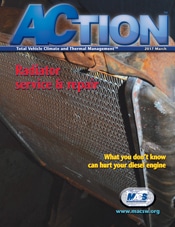What you don’t know can hurt your diesel engine

By Lauren Lewis
An introduction to heavy-duty coolant technology and best practices
Coolant has a few basic jobs in a vehicle’s engine, not the least of which is to absorb heat from components and dissipate it through the radiator into the surrounding air.
But the work is more demanding in a heavy-duty diesel.
The typical engine in a commercial truck, bus, or piece of off-highway equipment uses a wet-sleeve design, which means the pistons operate in cylinders surrounded by cast iron liners that come into direct contact with the coolant.
The combustion process causes these liners to vibrate rapidly, like a bell. This produces tiny vapor bubbles on the liner wall, and they implode with enough force to take little chunks out of the sleeve liner when they collapse. Left unchecked, these cavities will perforate the liner and allow coolant to mix with oil—a potentially catastrophic situation for the engine.
Heavy-duty coolant circulates chemicals to protect from this type of damage. In addition to removing heat and protecting liners, the coolant must to not react with the various materials it touches—aluminum, cast iron, copper, brass, and solder, plus non-metallic components like hoses and gaskets, including silicone. If the pH balance is too low, it can corrode cylinder blocks, heads, and liners. If it’s too high, it can harm gaskets and softer metals.
These are big tasks in addition to protecting against freezing and boil-over. Furthermore, the coolant’s chemical condition is constantly changing, so it’s important to maintain it as you would any other component on the vehicle.
Coolant classification
There are green coolants, red coolants, blue coolants, yellow coolants… In fact all heavy-duty coolant starts out as a colorless blend of water and a base, the most common being ethylene glycol (EG). The base lowers the freeze point and raises the boiling point of the coolant so it can transfer heat in more extreme temperatures than water alone can handle.
That being said, there is no universal color convention in the industry, and coolants of the same color are not guaranteed to be similar in composition or performance.
Instead of color, focus on performance standards, base type, and inhibitors.
Performance classification refers to a set of minimum testing standards or OEM specifications. ASTM D6210 is the American Society for Testing and Materials’ standard for glycol-based heavy-duty engine coolants and it evaluates a product’s ability to protect against liner pitting and scale. OEM standards go a step further to meet the needs of their specific engines, applications, and warranties. Check the packaging or product brochure to make sure your coolant meets your engine manufacturer’s requirements.
Type classifications can be made based on the coolant base type and inhibitor chemistry. EG-based coolants work in a wide range of climates and account for more than 90% of heavy-duty coolant sold in North America (propylene glycol is a less toxic alternative). Most OEMs require that the base be present in a concentration between 40 to 60%; you can check this in the field using a refractometer.
Finally, there are three terms to describe inhibitor chemistry: conventional, hybrid, and OAT (Organic Additive Technology).
Most conventional coolants come fully formulated with the proper mix of water, glycol, and SCAs and should meet ASTM D6210. This eliminates the need to “pre-charge” the coolant with supplemental coolant additives (SCAs).
Heavy-duty OAT coolants use organic acids like benzoic, sebacic, and adipic; OAT coolants don’t require SCAs and provide extended service intervals. Hybrid (HOAT) coolants typically have a longer life and service interval than conventional coolants but require more maintenance, which may include adding SCAs.
Both are initially more expensive than conventional coolant but cost less to maintain over the life of the vehicle. An extended service interval coolant typically only needs additive replenishment and filter change once per year, compared to conventional coolants with standard service intervals where the additive and filter are replenished at each oil change interval.

Common failures
Using the right coolant is important to preventing heavy-duty engine failures. Let’s walk through some of the most common:
• Liner pitting: You’ll see pitting most frequently on the side of the liner where the piston strikes just after the cylinder fires, and to a lesser degree on the opposite side where the cylinder strikes on the up-stroke. However, this type of damage can show up anywhere the level of vibration is high. Because of variations from cylinder to cylinder and engine to engine, no two liners will appear the same.
• Additive Dropout: When additives become unstable they can leave the coolant system unprotected against corrosion. Dropout can happen for several reasons, including coolant contamination, over-treatment of SCAs, and an improper mix of water, glycol, and inhibitors. Some additives will collect in the cool areas of the engine when instability occurs and impede heat transfer.
To reduce the risk of dropout, make sure the water used for mixing coolant is of good quality; most tap water is hard and can react with additives, causing them to become insoluble. When adding SCAs or extenders, more is not always better. If the additive concentration gets too high, the coolant will not be able to hold all of the additives in solution.
• Water Pump Failure: Hard water and additive dropout can lead to deposits on water pump face seals. So can particulate left by the manufacturing process of engine hardware.
Filtering these contaminants will not only reduce water pump failure, it can guard against engine wear, radiator failure, overheating, thermostat failure, and other coolant system component problems.
Water filters containing SCAs are a reliable way to meter out supplemental additives and coolant extenders during a service interval. For coolant systems above 20 gallons (76 liters), or if a liquid extender or SCA is used instead of a filter to replenish the SCA, use a blank water filter. For OAT coolants, blank water filters should be used.
• Corrosion: Historically, heavy-duty engines used a lot of cast iron and copper. But more heavy-duty coolant systems are incorporating aluminum radiators and oil coolers. The manufacturing process for these components uses a residual brazing compound that can partially dissolve into the coolant and introduce contamination. Some of the additives in conventional and hybrid coolants can have an adverse reaction in environments with brazing compound contamination and aggravate aluminum corrosion. When corrosion begins to occur, the aluminum is weakened and is prone to stress fractures.
OAT coolants are typically more robust for protecting against this type of contamination in the cooling system.
It’s estimated that 40% of all engine problems originate in the cooling system, meaning that selecting and maintaining your coolant is critical to protecting your equipment. When in doubt, follow the engine manufacturer’s recommendations for coolant type and service intervals. f
Lauren Lewis is Product Development Engineer, Coolants & Chemicals, at Cummins Filtration. She has a BS in Chemistry from Tennessee Tech University.
This article appeared in the March 2017 issue of ACTION Magazine.
Read the whole issue at this link http://www.nxtbook.com/nxtbooks/macs/action_201703


Leave a Reply